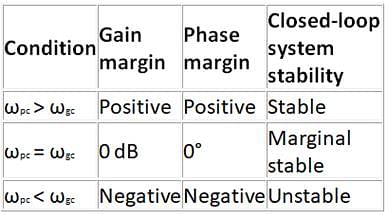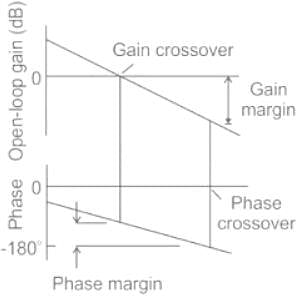Electrical Engineering (EE) Exam > Electrical Engineering (EE) Questions > System is said to be marginally stable, ifa)G...
Start Learning for Free
System is said to be marginally stable, if
- a)Gain crossover frequency > Phase crossover frequency
- b)Gain crossover frequency = Phase crossover frequency
- c)Gain crossover frequency < Phase crossover frequency
- d)Gain crossover frequency ≠ Phase crossover frequency
Correct answer is option 'B'. Can you explain this answer?
| FREE This question is part of | Download PDF Attempt this Test |
Most Upvoted Answer
System is said to be marginally stable, ifa)Gain crossover frequency &...
Gain Margin:
- The gain margin is a factor by which the gain of a stable system is allowed to increase before the system reaches the verge of instability.
- It is also defined as the reciprocal of the gain at which the phase angle becomes 1800.
- The frequency at which the phase angle is 1800 is called the phase crossover frequency (ωpc).
Mathematically,
∠G(jω)H(jω) = -180º
If |G(jω)H(jω)| = a, at ω = ωpc
Then Gain margin,

Phase Margin:
∠G(jω)H(jω) = -180º
If |G(jω)H(jω)| = a, at ω = ωpc
Then Gain margin,

Phase Margin:
- It is the amount of additional phase lag (at gain crossover frequency) that is required to bring the system to the verge of instability.
- The frequency at which |G(jω)H(jω|, the magnitude of the open-loop transfer function is unity is called gain crossover frequency (ωpc).
At ωpc, |G(jω)H(jω| = 1
if, ∠G(jω)H(jω) = ϕ at ω = ωgc
Then, P.M. = 180 + ϕ
Analysis:

For stable systems,
|G(jωpc)H(jωpc| < 1, and
∠G(jωgc)H(jωgc) > -180
so that, gain margin and phase margin both are positive
which is possible when ωgc < ωpc
For marginally stable systems,
ωgc = ωpc
Hence option (b) is the correct answer.

if, ∠G(jω)H(jω) = ϕ at ω = ωgc
Then, P.M. = 180 + ϕ
Analysis:

For stable systems,
|G(jωpc)H(jωpc| < 1, and
∠G(jωgc)H(jωgc) > -180
so that, gain margin and phase margin both are positive
which is possible when ωgc < ωpc
For marginally stable systems,
ωgc = ωpc
Hence option (b) is the correct answer.

Note: For stable systems having two or more gain crossover frequencies, the phase margin is measured at the highest gain crossover frequency.
Free Test
FREE
| Start Free Test |
Community Answer
System is said to be marginally stable, ifa)Gain crossover frequency &...
Marginally Stable System Explanation:
Marginally stable systems are characterized by having the gain crossover frequency equal to the phase crossover frequency. This condition indicates that the system is on the brink of stability, with a phase margin of exactly 0 degrees.
Explanation of Option 'B':
- Gain crossover frequency = Phase crossover frequency: This condition signifies that the gain margin and phase margin are both zero, which is a defining characteristic of a marginally stable system.
Therefore, in a marginally stable system, the gain crossover frequency is equal to the phase crossover frequency. This delicate balance between gain and phase margins is what defines the system's marginally stable behavior.
Attention Electrical Engineering (EE) Students!
To make sure you are not studying endlessly, EduRev has designed Electrical Engineering (EE) study material, with Structured Courses, Videos, & Test Series. Plus get personalized analysis, doubt solving and improvement plans to achieve a great score in Electrical Engineering (EE).

|
Explore Courses for Electrical Engineering (EE) exam
|

|
Similar Electrical Engineering (EE) Doubts
System is said to be marginally stable, ifa)Gain crossover frequency > Phase crossover frequencyb)Gain crossover frequency = Phase crossover frequencyc)Gain crossover frequency < Phase crossover frequencyd)Gain crossover frequency ≠ Phase crossover frequencyCorrect answer is option 'B'. Can you explain this answer?
Question Description
System is said to be marginally stable, ifa)Gain crossover frequency > Phase crossover frequencyb)Gain crossover frequency = Phase crossover frequencyc)Gain crossover frequency < Phase crossover frequencyd)Gain crossover frequency ≠ Phase crossover frequencyCorrect answer is option 'B'. Can you explain this answer? for Electrical Engineering (EE) 2024 is part of Electrical Engineering (EE) preparation. The Question and answers have been prepared according to the Electrical Engineering (EE) exam syllabus. Information about System is said to be marginally stable, ifa)Gain crossover frequency > Phase crossover frequencyb)Gain crossover frequency = Phase crossover frequencyc)Gain crossover frequency < Phase crossover frequencyd)Gain crossover frequency ≠ Phase crossover frequencyCorrect answer is option 'B'. Can you explain this answer? covers all topics & solutions for Electrical Engineering (EE) 2024 Exam. Find important definitions, questions, meanings, examples, exercises and tests below for System is said to be marginally stable, ifa)Gain crossover frequency > Phase crossover frequencyb)Gain crossover frequency = Phase crossover frequencyc)Gain crossover frequency < Phase crossover frequencyd)Gain crossover frequency ≠ Phase crossover frequencyCorrect answer is option 'B'. Can you explain this answer?.
System is said to be marginally stable, ifa)Gain crossover frequency > Phase crossover frequencyb)Gain crossover frequency = Phase crossover frequencyc)Gain crossover frequency < Phase crossover frequencyd)Gain crossover frequency ≠ Phase crossover frequencyCorrect answer is option 'B'. Can you explain this answer? for Electrical Engineering (EE) 2024 is part of Electrical Engineering (EE) preparation. The Question and answers have been prepared according to the Electrical Engineering (EE) exam syllabus. Information about System is said to be marginally stable, ifa)Gain crossover frequency > Phase crossover frequencyb)Gain crossover frequency = Phase crossover frequencyc)Gain crossover frequency < Phase crossover frequencyd)Gain crossover frequency ≠ Phase crossover frequencyCorrect answer is option 'B'. Can you explain this answer? covers all topics & solutions for Electrical Engineering (EE) 2024 Exam. Find important definitions, questions, meanings, examples, exercises and tests below for System is said to be marginally stable, ifa)Gain crossover frequency > Phase crossover frequencyb)Gain crossover frequency = Phase crossover frequencyc)Gain crossover frequency < Phase crossover frequencyd)Gain crossover frequency ≠ Phase crossover frequencyCorrect answer is option 'B'. Can you explain this answer?.
Solutions for System is said to be marginally stable, ifa)Gain crossover frequency > Phase crossover frequencyb)Gain crossover frequency = Phase crossover frequencyc)Gain crossover frequency < Phase crossover frequencyd)Gain crossover frequency ≠ Phase crossover frequencyCorrect answer is option 'B'. Can you explain this answer? in English & in Hindi are available as part of our courses for Electrical Engineering (EE).
Download more important topics, notes, lectures and mock test series for Electrical Engineering (EE) Exam by signing up for free.
Here you can find the meaning of System is said to be marginally stable, ifa)Gain crossover frequency > Phase crossover frequencyb)Gain crossover frequency = Phase crossover frequencyc)Gain crossover frequency < Phase crossover frequencyd)Gain crossover frequency ≠ Phase crossover frequencyCorrect answer is option 'B'. Can you explain this answer? defined & explained in the simplest way possible. Besides giving the explanation of
System is said to be marginally stable, ifa)Gain crossover frequency > Phase crossover frequencyb)Gain crossover frequency = Phase crossover frequencyc)Gain crossover frequency < Phase crossover frequencyd)Gain crossover frequency ≠ Phase crossover frequencyCorrect answer is option 'B'. Can you explain this answer?, a detailed solution for System is said to be marginally stable, ifa)Gain crossover frequency > Phase crossover frequencyb)Gain crossover frequency = Phase crossover frequencyc)Gain crossover frequency < Phase crossover frequencyd)Gain crossover frequency ≠ Phase crossover frequencyCorrect answer is option 'B'. Can you explain this answer? has been provided alongside types of System is said to be marginally stable, ifa)Gain crossover frequency > Phase crossover frequencyb)Gain crossover frequency = Phase crossover frequencyc)Gain crossover frequency < Phase crossover frequencyd)Gain crossover frequency ≠ Phase crossover frequencyCorrect answer is option 'B'. Can you explain this answer? theory, EduRev gives you an
ample number of questions to practice System is said to be marginally stable, ifa)Gain crossover frequency > Phase crossover frequencyb)Gain crossover frequency = Phase crossover frequencyc)Gain crossover frequency < Phase crossover frequencyd)Gain crossover frequency ≠ Phase crossover frequencyCorrect answer is option 'B'. Can you explain this answer? tests, examples and also practice Electrical Engineering (EE) tests.

|
Explore Courses for Electrical Engineering (EE) exam
|

|
Suggested Free Tests
Signup for Free!
Signup to see your scores go up within 7 days! Learn & Practice with 1000+ FREE Notes, Videos & Tests.
























